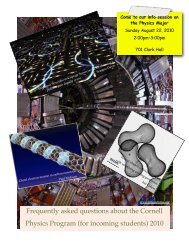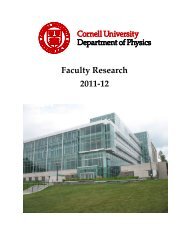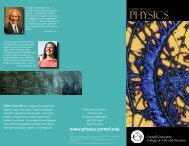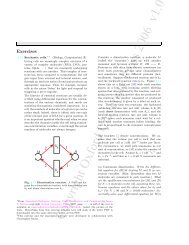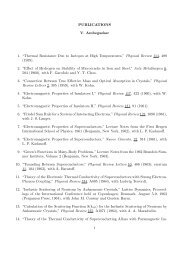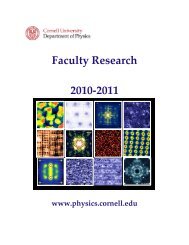Physics Freshman Brochure
Physics Freshman Brochure
Physics Freshman Brochure
- No tags were found...
You also want an ePaper? Increase the reach of your titles
YUMPU automatically turns print PDFs into web optimized ePapers that Google loves.
Sample Homework Problems<br />
P112<br />
P116<br />
(from problem set 1, Spring 2007)<br />
A bicycle travels a distance D up a gentle hill at steady<br />
speed v 1 and then continues down the other side of the<br />
hill the same distance D at steady speed v 2. Derive an<br />
algebraic expression for the bicycle's average speed v av<br />
for the entire trip in terms of v 1 and v 2. Please simplify<br />
your expression if possible. Does v av depend on the<br />
distance D [HINT: The answer is not (v 1 + v 2)/2.]<br />
(from problem set 1, Spring 2009)<br />
A car's maximum acceleration when speeding up is a,<br />
and can brake at a maximum deceleration d. What is<br />
the minimum time that it will take the car to traverse a<br />
distance L, given that it must start AND end at rest<br />
(from problem set 3, Spring 2006)<br />
A baseball is given an initial velocity with magnitude<br />
v 0 at an angle " above the surface of an incline, which<br />
is in turn inclined an an angle # above the horizontal.<br />
(a) Calculate the distance, measured along the incline,<br />
from the launch point to where the baseball strikes the<br />
incline. (b) What angle gives the maximum range<br />
(from problem set 1, Spring 2009)<br />
You are standing on the top of a hill whose downward<br />
slope makes an angle # with the horizontal. Ignoring<br />
air resistance, at what angle should you throw a rock<br />
such that it travels the maximum horizontal distance<br />
away from you before hitting the slope<br />
(from problem set 5, Spring 2006)<br />
The International Space Station (ISS) orbits the Earth<br />
in an approximately circular orbit at a height of about<br />
240 miles (384 km) above the Earth's surface. What is<br />
the speed of the space station in its orbit (in km/s)<br />
What is the space station's orbital period (in hours)<br />
(from problem set 2, Spring 2009)<br />
Consider two planets in space with mass M and m,<br />
which orbit in a circular manner around each other<br />
with a period T. The planets experience an attractive<br />
force between each other of magnitude F. What is the<br />
distance D between the planets, in terms of M, m, F,<br />
and T<br />
(from problem set 5, Spring 2006)<br />
A passenger with mass 85 kg rides in a Ferris wheel in<br />
which the seats travel in a circle of radius 35 m. The<br />
Ferris wheel rotates at constant speed, and makes one<br />
complete revolution every 25 s. Calculate the<br />
magnitude and direction of the net force exerted on<br />
the passenger by the seat when she is (a) one-quarter<br />
revolution past her lowest point and (b) one-quarter<br />
revolution past her highest point.<br />
(from problem set 3, Spring 2009)<br />
A circular loop of rope of length L and mass M sits on<br />
a frictionless table. The loop is spun around its center<br />
with an angular velocity w. Find the tension in the<br />
rope.<br />
Style of problems, and timing of syllabus may vary by instructor.



